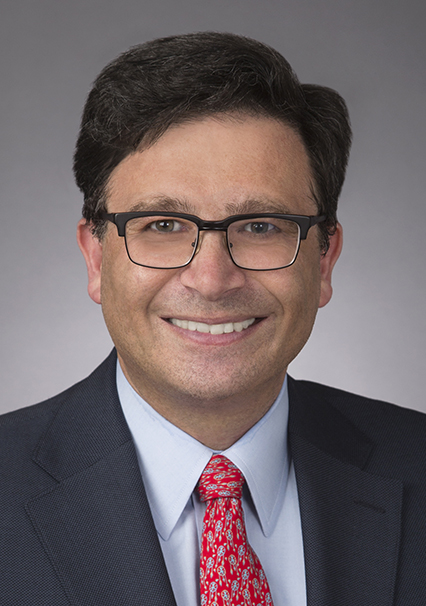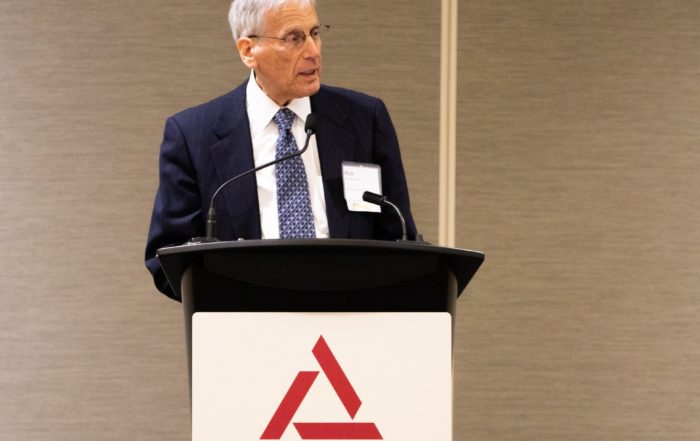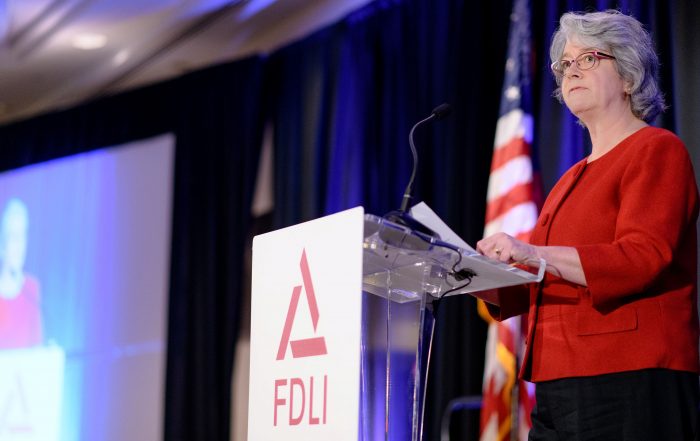3rd Annual Eric M. Blumberg Memorial Lecture
December 10, 2015
 Introduction / Reflections on Rick Blumberg
Introduction / Reflections on Rick Blumberg
It is a privilege to speak before you today in memory of Rick Blumberg, a man whom I knew as the irreverent enforcer. He was a true warrior for public health, a good, idealistic man whom you wanted with you on any brief, in any courtroom, and by your side. Rick believed in FDA’s mission and the law and perhaps no other attorney in the last four decades has served the FDA cause as did Rick. He was a no-nonsense guy famous for rough language, a keen intellect, and a belief in thoroughness, all in to serve the public.
Change In The World And Within FDA
Rick began his career at FDA in 1970, less than a year out of Georgetown Law School. He rose to become the deputy chief counsel for litigation in 1991, a position he occupied until 2013. It was during this time that changes – in the outside world and within FDA – began to accelerate, from the emergence of the Internet to a revolution in global transportation and a closely connected global economy. These changes required adaptive new ways to protect public health.
For FDA, the 1970s, 1980s, and 1990s were a period of reliance on judicial enforcement against adulterated products using seizures and injunctions. But now we can supplement this approach with new tools.
Not long after, at the dawn of Rick’s fourth decade with FDA, FSMA became law. Then FDASIA. It was clear the ethos was changing: From enforcement alone, to coupling it with achieving compliance through prevention, reliance on other partner regulators, and administrative actions – and now, our new tools are changing the way FDA operates.
For example, we issue far more import alerts, which are crucial in a global economy as a way to keep dangerous products out of our nation’s stream of commerce.
We use the Internet to increase our transparency, and in doing so, bring immediate attention to suspect actors. We post warning letters, for example, so purchasers can quickly evaluate information about firms with whom they do business.
These new tools help protect our complex supply chains and a realm of new actors, not all good, created by the World Wide Web. These are rapid and effective administrative actions – and don’t rely on the court system.
Another hallmark of our transforming FDA has been the opening of foreign offices in key, exporting nations. We’ve for some time been cooperating with and relying on trusted foreign and state regulatory partners. Multilateral institutions are growing stronger.
Yes, we are still using warning letters, seizures, and injunctions to deal with the problems that we observe. Criminal enforcement is now an even more vital part of our enforcement effort. Indeed, the Office of Criminal Investigations didn’t even exist when Rick joined the agency – it was established in 1991. But we are also now incentivizing firms to create systems to prevent problems in the first place.
The shift sparked by legislation, FDA’s adjustment to globalized manufacturing and trade, and our administrative actions – these all took place during Rick’s four-decade tenure at the agency. We are modernizing and improving our approach to compliance and enforcement and this new approach, as I noted, will be coupled with our strong criminal enforcement program.
I want to emphasize, as we honor Rick with this Memorial Address, that throughout this history, Rick was there, adapting to a changing world and helping FDA adapt as well.
FSMA and Enforcement
As Rick’s colleague – and mine as well – Mike Taylor emphatically notes:
About one in six Americans get sick, 128,000 are hospitalized, and 3,000 die each year from foodborne diseases. This is a significant public health burden that is largely preventable.
The Food Safety and Modernization Act (FSMA) is a prevention catalyst. Last year, we released our FSMA Operational Strategy, which outlines the plans and guiding principles for implementing FSMA. And, of course, we recently issued final rules that, for the first time, establish enforceable safety standards for produce farms and make importers accountable for verifying that imported food meets U.S. safety standards.
The Agency also issued a rule establishing a program for the accreditation of third-party certification bodies, also known as auditors, to conduct food safety audits of foreign food facilities.
FSMA recognizes that the most effective way to ensure a safe food supply is ensuring actors throughout the global food supply chain assume responsibility to implement science and risk-based preventive measures across the farm-to-table spectrum. A matter of routine practice, every day.
FSMA’s public health prevention focus and new administrative enforcement tools mean that FDA’s thrust in resolving problems that put consumers at risk follows a sequence: voluntary measures and then administrative procedures. Here’s a brief example of this system:
- Voluntary correction of problems at the facility level, achieved immediately during the course of an inspection through communication with firm management by investigators and, as needed, Center technical staff;
- Administrative correction achieved at the District level through deficiency letters, issued within days after an inspection with Center back-up, to document significant safety-related deficiencies and request correction within a specified period, with immediate inspection follow-up to verify correction;
- Administrative detention of product if needed to provide immediate public health protection or for other appropriate purposes;
- Voluntary and mandatory recalls to remove potentially hazardous food from the market; and,
- Administrative suspension of registration when other administrative compliance measures have failed to achieve correction of significant deficiencies that put consumers at risk.
In addition to this expanded spectrum of voluntary and administrative actions, I must emphasize: We will continue to use judicial enforcement when necessary to complement non-judicial compliance actions and address matters for which there is no adequate administrative remedy, such as:
- Seizure actions that are needed to back up administrative detentions;
- Injunction actions when suspension of registration or other measures are inadequate to prevent future non-compliance; and,
- Criminal prosecution for falsifying records, lying to FDA, and knowingly putting consumers at risk.
And we will also work closely with our state partners to coordinate our enforcement approaches. Under FSMA, enforcement is becoming more prevention focused, more targeted — and smarter.
IV. Enforcement in the Drug Realm
Similar to the new thrust in food safety is the new thrust in pharmaceutical enforcement and quality.
In the past three years, two major pieces of legislation – the Food and Drug Administration Safety and Innovation Act (FDASIA) and the Drug Quality and Security Act (DQSA) – have allowed us to expand the tools that we use to encourage industry to produce safe and effective drugs. The aim that we have is not just the legal floor of “compliance” but a marketplace and an agency that incentivizes high levels of quality beyond the legal minimum.
Now, as I noted earlier, a few years ago, our regulatory menu consisted largely of inspections, seizures, injunctions, and warning letters.
While we will continue to use these important tools, the new statutes have enabled us to broaden our approach; an approach will be coupled with our strong criminal enforcement program.
FDASIA promotes innovation to speed patient access to safe and effective products. It also has increased stakeholder involvement in FDA processes and is already enhancing the safety of the drug supply chain.
FDASIA gives us the tools to inspect firms in a more risk-based fashion and to achieve parity between foreign and domestic firms. The law allows us to ask for information from firms in lieu of or to guide and focus our inspections.
As well, the new law gives us the power to block imports in the event we are kept from inspecting an overseas facility, or when companies refuse to provide full and complete information on their products.
The second recent major statute is the Drug Quality and Security Act (DQSA).
A key provision of this legislation is Title Two, known as the Track and Trace provision, which outlines steps to build an electronic, interoperable system identifying and tracing certain prescription drugs as they are distributed in the United States.
Our ultimate goal is to identify each individual prescription drug package in a way that will enable rapid and accurate verification of the legitimacy of the product, which will be an important tool in the fight against counterfeit drugs. If a counterfeit or other harmful drug is discovered in the supply chain, we can immediately notify patients, health care professionals, hospitals and others about the public health risk. This system will also help to enable more efficient recalls to remove drugs from the market that are considered potentially dangerous.
V. Conclusion
Rick Blumberg began his incomparable career in an era of Telex machines and operated-assisted long distance calls and he departed us in an age of instant messaging. He was skilled and dynamic, a determined and fierce litigator. And yet he was flexible and savvy enough to help guide our agency through four decades of transformation in how we protect the public health.
To put it simply, when Rick began at FDA, we would perform inspections that found a misbranded or adulterated product or unacceptable manufacturing conditions.
Often, the product was already on the market. We dealt with that public health risk by going to court to stop it from reaching more consumers and patients and pursuing a recall if necessary. And today, we will not hesitate to use vigorous enforcement, including criminal enforcement, in these situations. But what we hope to do now is to prevent these products from reaching American dinner tables and medicine cabinets in the first place. So, we will work to ensure that firms will adapt and implement FSMA’s preventive framework and that medical product firms not expose patients to products that are of poor quality. We will do this using the tools I have outlined, including a strong enforcement program.
Rick recognized the need for energetic, public health-oriented enforcement that not only removed dangerous products from the marketplace but also provided a swift deterrent. He knew that enforcement helps industry as well, by maintaining a level playing field for safe products and by making sure that offenders are held legally accountable, all of which prevents companies from having to choose between doing the right thing and staying competitive. Rick knew that effective enforcement, litigation and compliance strategies create public confidence in FDA oversight, which in turn keeps trust in the safety of FDA-regulated products from eroding.
It’s an honor to stand here today, remembering my friend – our friend – Rick Blumberg. I know this is a room of individuals with whom Rick would have felt exceedingly comfortable. He probably wouldn’t have spared us his sometimes salty language. But he would have reminded us – just with his presence – that we were with an archetype of the forceful, tough, and steadfast public servant. FDA was fortunate to have him, as were we all.
Thank you.







